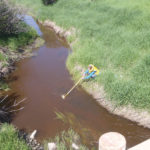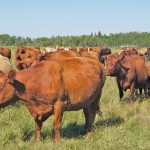As more and more farmers, politicians and laypeople are coming to understand, nutrient run-off from farm fields into waterways is a very big deal. When not managed properly, nutrients from fertilizer and manure make their way into creeks, lakes, dugouts, and other water bodies. But a new tool to help mitigate phosphorus run-off risk will

New tool for managing nutrient run-off
Free downloadable tool for assessing phosphorus run-off risk and creating a customized mitigation plan will be available this spring

It’s buyer beware when purchasing crop fertilizer: don’t pay $12 per acre for ‘foo-foo dust’
The Canadian Food Inspection Agency no longer tests fertilizers for efficacy and quality, so it’s buyer beware
A “streamlining” of federal oversight of crop fertilizers has opened the door to deceptive marketing claims and forced product testing on to farmers. “There have always been con men trying to sell you things with dubious claims. It’s just maybe easier for them now,” said Harry Brook, a crop specialist with Alberta Agriculture and Rural

The fight for the future of forages
There has been a dramatic drop in forage research, but it’s not just because producers could make more money growing canola
What’s Canada largest crop? The usual answer is “wheat,” which in 2012 was seeded on about 20 million acres. But that year, cultivated forages made up 33 million acres, and more than 36 million acres were in native or unimproved pastures and rangeland. Yet farmers who manage grasslands and forage fields say their industry is
A game of tag — which RFID system is better?
The race is on to create an approved and industry-implementable version of ultra-high-frequency (UHF) radio frequency identification (RFID) livestock ear tags. Though there could be big money in it for the winner, design challenges and political roadblocks stand in the way. Compared to older technology, UHF is 2,000 times faster and easier to read, can
Farmers now have the ability to conduct their own cutting-edge ag research
Conducting your own field-based studies can show exactly how a specific agronomic practice will perform in a particular field
Farmers need to step up and get involved in a new era of research, and it needs to be on farm, field scale, farmer driven, and collaborative, says Ty Faechner, executive director of the Agricultural Research and Extension Council of Alberta. “I don’t think traditional research will ever go away,” Faechner told attendees at theCanadian-EU Beef Exports Become More Economic
Canadian beef may soon have easier access to European Union (EU) markets, thanks to upcoming revisions to the production and processing protocol that governs Europe s imports of Canadian beef. These changes would be very significant, says Mark Klassen, director of technical services for the Canadian Cattlemen s Association, who has been working with industry
High-tech ear tags to be put to the test
High-tech livestock ear tags are a step closer to reality in Alberta, thanks to a recent big dollar commitment towards a trial of Ultra High Frequency (UHF) tags. The end-to-end test will track animals through all parts of the beef production cycle, from the producer’s field, through auction markets, feedlots and to the processor. The
BSE-Testing Argument Continues To Have Financial Potential
Lawyer and Alberta rancher David Pope is on a one-man crusade to gain market access for Canadian beef in Japan. For the cost of a $15-per-carcass BSE test, Pope argues Canadian cattle could fetch as much as $500 per head above current prices. Pope has been waging his crusade for the past five years, but
Agency In The Forefront Of High-Tech Changes
Livestock inspection in Alberta is going high tech. The move from handwritten brand log books to a system relying on leading-edge databases and high-tech livestock-movement tools is being pushed by Livestock Identification Services Ltd. (LIS), the non-profit organization in charge of livestock inspection in Alberta. The goal is to optimize costs, improve the “tool kit”
A Primer On UHF And RFID Tag Readers
EAR TAG RULES: Required for all cattle, sheep, and bison leaving the herd of origin in Canada. The national livestock identification program is administered by the Canadian Cattle Identification Agency in cooperation with the Canadian Food Inspection Agency. RADIO FREQUENCY IDENTIFICATION (RFID) TAGS: Several low-frequency RFID tags are approved for use in Canada; all operate

